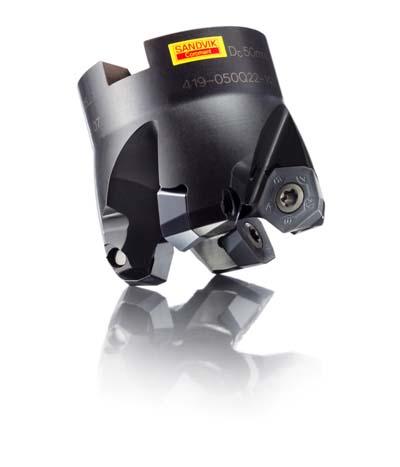
CoroMill 419 from Sandvik Coromant Co. is a new five-edge high-feed milling concept for roughing to semi-finishing, offering excellent performance in all material groups and with great possibilities for optimization.
The new milling cutter is suitable for most applications and industry segments requiring high feed face and profile milling. It is well suited to machining of components requiring long overhangs and even perfect for lower-power machines and weak fixtures.
Its benefits include, high productivity in applications requiring light cutting action and long tool life, especially in difficult-to-machine materials with an optimization for stainless steel, hardened steel and titanium.
Through coolant on all cutters enables efficient wet machining and the option of compressed air cooling provides improved chip evacuation in deep cavity milling and helical interpolation.
CoroMill 419 is equipped with strong and robust inserts for reliable machining with five cutting edges. It is available with a wide range of insert grades and geometries, giving you a choice for most materials and applications. CoroMill 419 is available in diameter range 32-100mm (1.25-4 inch).
Contact Details
Related Glossary Terms
- coolant
coolant
Fluid that reduces temperature buildup at the tool/workpiece interface during machining. Normally takes the form of a liquid such as soluble or chemical mixtures (semisynthetic, synthetic) but can be pressurized air or other gas. Because of water’s ability to absorb great quantities of heat, it is widely used as a coolant and vehicle for various cutting compounds, with the water-to-compound ratio varying with the machining task. See cutting fluid; semisynthetic cutting fluid; soluble-oil cutting fluid; synthetic cutting fluid.
- feed
feed
Rate of change of position of the tool as a whole, relative to the workpiece while cutting.
- gang cutting ( milling)
gang cutting ( milling)
Machining with several cutters mounted on a single arbor, generally for simultaneous cutting.
- interpolation
interpolation
Process of generating a sufficient number of positioning commands for the servomotors driving the machine tool so the path of the tool closely approximates the ideal path. See CNC, computer numerical control; NC, numerical control.
- milling
milling
Machining operation in which metal or other material is removed by applying power to a rotating cutter. In vertical milling, the cutting tool is mounted vertically on the spindle. In horizontal milling, the cutting tool is mounted horizontally, either directly on the spindle or on an arbor. Horizontal milling is further broken down into conventional milling, where the cutter rotates opposite the direction of feed, or “up” into the workpiece; and climb milling, where the cutter rotates in the direction of feed, or “down” into the workpiece. Milling operations include plane or surface milling, endmilling, facemilling, angle milling, form milling and profiling.
- milling cutter
milling cutter
Loosely, any milling tool. Horizontal cutters take the form of plain milling cutters, plain spiral-tooth cutters, helical cutters, side-milling cutters, staggered-tooth side-milling cutters, facemilling cutters, angular cutters, double-angle cutters, convex and concave form-milling cutters, straddle-sprocket cutters, spur-gear cutters, corner-rounding cutters and slitting saws. Vertical cutters use shank-mounted cutting tools, including endmills, T-slot cutters, Woodruff keyseat cutters and dovetail cutters; these may also be used on horizontal mills. See milling.

